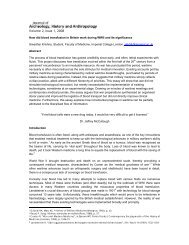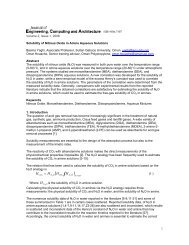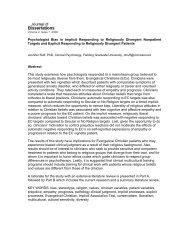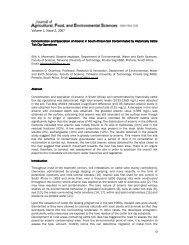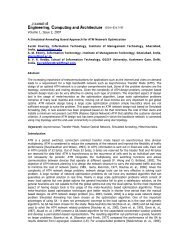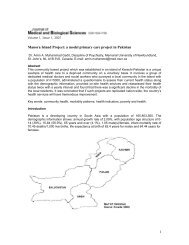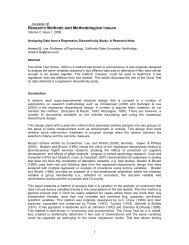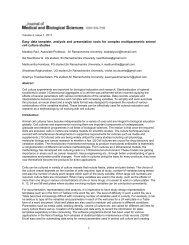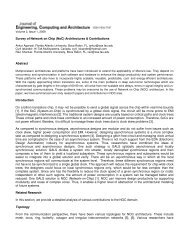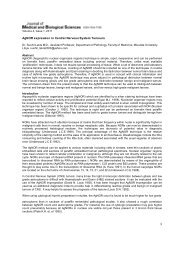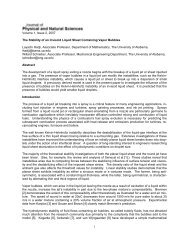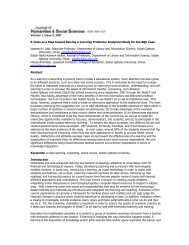The Heaven and Earth Society and the Red Turban Rebellion in ...
The Heaven and Earth Society and the Red Turban Rebellion in ...
The Heaven and Earth Society and the Red Turban Rebellion in ...
Create successful ePaper yourself
Turn your PDF publications into a flip-book with our unique Google optimized e-Paper software.
However, by far <strong>the</strong> most significant event took place <strong>in</strong> 1853 when <strong>the</strong> Taip<strong>in</strong>g captured Nanj<strong>in</strong>g<br />
<strong>and</strong> establish this city as <strong>the</strong>ir <strong>Heaven</strong>ly K<strong>in</strong>gdom. <strong>The</strong> local disaffected elements, especially <strong>the</strong> secret<br />
societies, were very much excited by <strong>the</strong>se disturbances that kept <strong>the</strong> local officials <strong>and</strong> officers very busy<br />
<strong>in</strong>deed. One of <strong>the</strong> secret society proclamations, which appears among British Foreign Office papers, reads,<br />
“<strong>The</strong> ancient books tell us that once <strong>in</strong> five centuries some man of talent beyond his fellows will appear, on<br />
whom <strong>the</strong> hope of <strong>the</strong> nation will depend. That period has elapsed s<strong>in</strong>ce <strong>the</strong> rise of <strong>the</strong> M<strong>in</strong>g dynasty, <strong>and</strong> it<br />
is full time that a hero should come forward <strong>and</strong> save <strong>the</strong> nation.” 32<br />
From April, Ti<strong>and</strong>ihui activity became <strong>in</strong>creas<strong>in</strong>gly menac<strong>in</strong>g around Guangzhou. Reports were<br />
also received of disorder <strong>in</strong> Huizhou 惠 州 to <strong>the</strong> west of <strong>the</strong> prov<strong>in</strong>cial city. In Guangdong <strong>the</strong> gentry<br />
belatedly began to take a more active part <strong>in</strong> organiz<strong>in</strong>g militia units. But <strong>in</strong> October <strong>the</strong> situation fur<strong>the</strong>r<br />
deteriorated when a b<strong>and</strong> allied with <strong>the</strong> Small Sword rebels of Amoy were driven out of <strong>the</strong>ir center at <strong>the</strong><br />
Bogue, to <strong>the</strong> south of Guangzhou, <strong>and</strong> established <strong>the</strong>mselves <strong>in</strong> Huizhou. In <strong>the</strong> follow<strong>in</strong>g months severe<br />
disorders were reported from Huizhou <strong>and</strong> Dong’guan. 33 <strong>The</strong> disturbed state of <strong>the</strong> prov<strong>in</strong>ce provided an<br />
ideal sett<strong>in</strong>g for <strong>the</strong> fur<strong>the</strong>r widespread disturbances known as <strong>the</strong> <strong>Red</strong> <strong>Turban</strong> rebellion.<br />
<strong>The</strong> Beg<strong>in</strong>n<strong>in</strong>g <strong>and</strong> High Tide of <strong>the</strong> <strong>Red</strong> <strong>Turban</strong> <strong>Rebellion</strong><br />
Q<strong>in</strong>g government official records from various sources confirm that <strong>the</strong> beg<strong>in</strong>n<strong>in</strong>g of <strong>the</strong> <strong>Red</strong><br />
<strong>Turban</strong> rebellions are dated on June 17, 1854 <strong>in</strong> <strong>the</strong> village of Shi'long 石 龍 where a smuggler <strong>and</strong> a local<br />
Ti<strong>and</strong>ihui leader named He Liu led an attack on <strong>the</strong> district city, Dong’guan 東 莞莞 (about 20 miles east of<br />
Guangzhou) <strong>and</strong> sacked it. 34 <strong>The</strong> revolt was not sudden one. 35 By <strong>the</strong> beg<strong>in</strong>n<strong>in</strong>g of 1854, Ye M<strong>in</strong>gchen was<br />
already receiv<strong>in</strong>g urgent dispatches from his agents <strong>in</strong>form<strong>in</strong>g him that every day <strong>in</strong> <strong>the</strong> suburbs of<br />
Guangzhou, hundreds upon hundreds of people were secretly assembl<strong>in</strong>g <strong>and</strong> <strong>the</strong>n as secretly dispers<strong>in</strong>g.<br />
<strong>The</strong>se assemblies were <strong>in</strong> fact secret society ga<strong>the</strong>r<strong>in</strong>gs <strong>in</strong> which were held <strong>the</strong> ceremonies of admitt<strong>in</strong>g new<br />
members. 36 Trouble had been brew<strong>in</strong>g for some time, but it was not reported to <strong>the</strong> capital until it became<br />
too extensive to conceal.<br />
All <strong>the</strong> <strong>in</strong>surrectionists <strong>and</strong> <strong>the</strong>ir collaborators wore red turbans for a sign, which earned <strong>the</strong>m <strong>the</strong><br />
name of “Hongj<strong>in</strong>ze 紅 巾 賊 (<strong>Red</strong> <strong>Turban</strong> B<strong>and</strong>it)” or “Hongdouze 紅 頭 賊 (<strong>Red</strong> Head B<strong>and</strong>it)”. <strong>The</strong>y were<br />
also called as “Hongb<strong>in</strong>g 洪 兵 (Vast Soldiers or Triad Soldiers)” s<strong>in</strong>ce <strong>the</strong> <strong>Red</strong> <strong>Turban</strong>s used <strong>the</strong> <strong>in</strong>signia<br />
<strong>and</strong> watchwords of <strong>the</strong> Ti<strong>and</strong>ihui. 37 Official records of <strong>the</strong> Q<strong>in</strong>g government <strong>in</strong> <strong>the</strong> Canton Archives provide<br />
us <strong>the</strong> picture of cooperation between various Ti<strong>and</strong>ihui lodges. 38 <strong>The</strong> pr<strong>in</strong>cipal prize was, of course,<br />
Guangzhou itself, <strong>and</strong> <strong>in</strong> <strong>the</strong> summer of 1854, <strong>the</strong> <strong>Red</strong> <strong>Turban</strong>s came close to tak<strong>in</strong>g <strong>the</strong> city. 39<br />
Before 1854, <strong>the</strong> primary organizations of <strong>the</strong> <strong>Red</strong> <strong>Turban</strong> groups were those of numerous b<strong>and</strong>s,<br />
with which <strong>the</strong> leaders sought to satisfy <strong>the</strong>ir followers’ desires for material ga<strong>in</strong> or mutual aid. <strong>The</strong> first<br />
characteristic of orig<strong>in</strong>al Ti<strong>and</strong>ihui units was <strong>the</strong>ir geographical decentralization. Before 1854, one could<br />
hardly po<strong>in</strong>t out a site that might be considered as <strong>the</strong>ir political or military headquarters. Secondly, <strong>the</strong><br />
numerous b<strong>and</strong>s were <strong>in</strong>dependent of one ano<strong>the</strong>r. This characteristic is revealed by <strong>the</strong> fact that each b<strong>and</strong><br />
32 F.O. 17.126, Bowr<strong>in</strong>g-Clarendon, Desp. 18 (Jan. 9, 1855).<br />
33 Wakeman, Strangers, 138.<br />
34 This was about one year after <strong>the</strong> Taip<strong>in</strong>gs established <strong>the</strong>ir capital at Nanj<strong>in</strong>g, <strong>and</strong> <strong>in</strong>deed, <strong>the</strong> conflict<br />
was to some extent <strong>in</strong>spired by <strong>the</strong> Taip<strong>in</strong>gs. <strong>The</strong> Taip<strong>in</strong>gs even sent <strong>the</strong>ir secret agents back to Guangdong<br />
to contact <strong>the</strong> secret societies <strong>the</strong>re <strong>in</strong> hope of stirr<strong>in</strong>g up a general upris<strong>in</strong>g. See Daq<strong>in</strong>g Lichao shilu,<br />
Xianfeng period 大 淸 朝 實 錄 , 咸 豊 朝 (Taibei, repr<strong>in</strong>t 1964), <strong>and</strong> 142.11. Imperial edict, 8 (Oct. 1854);<br />
F.O. 682.340.13.12 (Sep. 1854); idem, 68.4.46 (1855).<br />
35 Shunde Xianzhi 順 德 縣 志 , 23:5.b.<br />
36 F.O. 931.1512-1514.<br />
37 Soda Yo 相 田 洋 , “Kok<strong>in</strong>ko 紅 巾 考 ,” Toyoshi Kenkyu 東 洋 史 硏 究 , 38.4 (March 1980), 38-4, 57;<br />
Wakeman, Strangers, Chapter 14.<br />
38 <strong>The</strong> rebel b<strong>and</strong>s generally cooperated with one ano<strong>the</strong>r while ma<strong>in</strong>ta<strong>in</strong><strong>in</strong>g <strong>the</strong>ir <strong>in</strong>dividual activities. Only<br />
occasionally did <strong>the</strong>y fight among <strong>the</strong>mselves. <strong>The</strong> sources regularly mention almost 34 major rebel leaders<br />
<strong>and</strong> many m<strong>in</strong>or ones. <strong>The</strong> number of separate b<strong>and</strong>s was considerably less, for quite a few leaders shared<br />
comm<strong>and</strong> of s<strong>in</strong>gle groups or took over comm<strong>and</strong> after someone else was killed or captured. See F.O.<br />
931.1497.<br />
39 Lu Baoqian 陸 寶 千 . Lun wan-q<strong>in</strong>g Liangguang de Ti<strong>and</strong>ihui zhengquan 論 晩晩 淸 兩 廣 的 天 地 會 政 權<br />
(Taibei: Zhongyang yanjiu j<strong>in</strong>daishi yanjiusuo, 1975), 133-142.<br />
7



